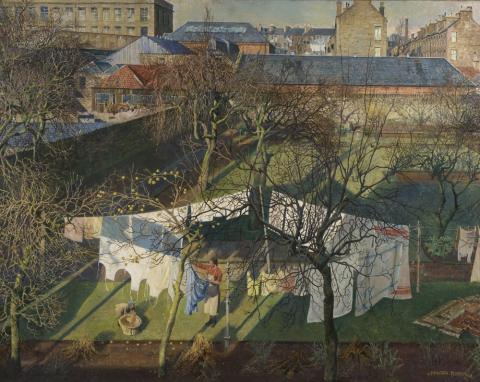
As lockdown restrictions begin to ease, art historian and curator Alice Strang reflects on the past few months in paintings in our modern Scottish art collection.
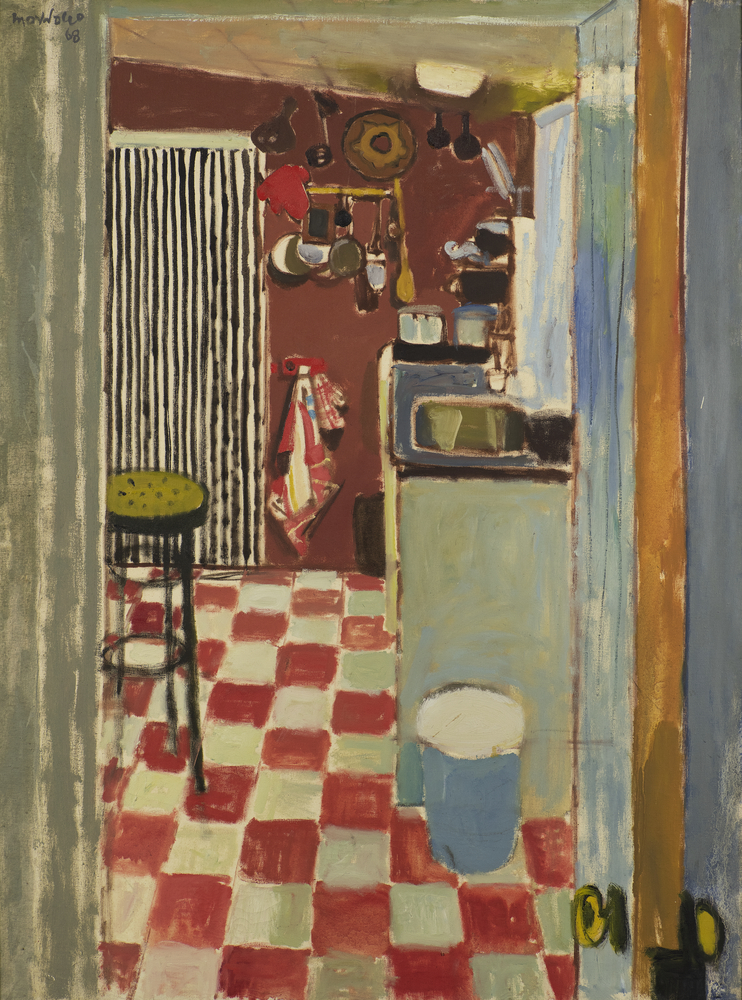
Alberto Morrocco (1917-98), The Striped Curtain, 1968 © The Artist’s Estate
Living under lockdown has meant that most of us have spent more time than usual at home. The Striped Curtain of 1968 by Alberto Morrocco (1917-98) celebrates our everyday surroundings in a lively kitchen interior. Morrocco was born in Aberdeen to Italian parents. He studied at Gray’s School of Art in the city, under James Cowie (1886-1956) and Robert Sivell (1888-1958). In 1941 he married Vera Mercer and following his appointment to the staff of Duncan of Jordanstone College of Art in 1950, they moved to Dundee. Morrocco was to remain in the post of Head of Painting until his retirement in 1982.
Although the title of The Striped Curtain calls attention to the striking fabric hung in the background of the painting, much of the work is based on pattern and fields of colour. The eye is drawn from the sharp perspective of the open door in the right foreground, through the doorway, from blue bin to yellow-topped stool standing on chequered floor, to the jumble of tea towels and kitchen utensils clustered on the back wall. The kitchen sink unit, neighbouring work surface and companion window are rendered in rectangular forms which rise to meet the sloping ceiling. The viewer is invited in to the welcoming, naturally-lit room, a place one feels would be nice to spend lockdown time in. This work was purchased for Dundee City Council’s Education Department and was transferred to the city’s permanent collections in 2012.
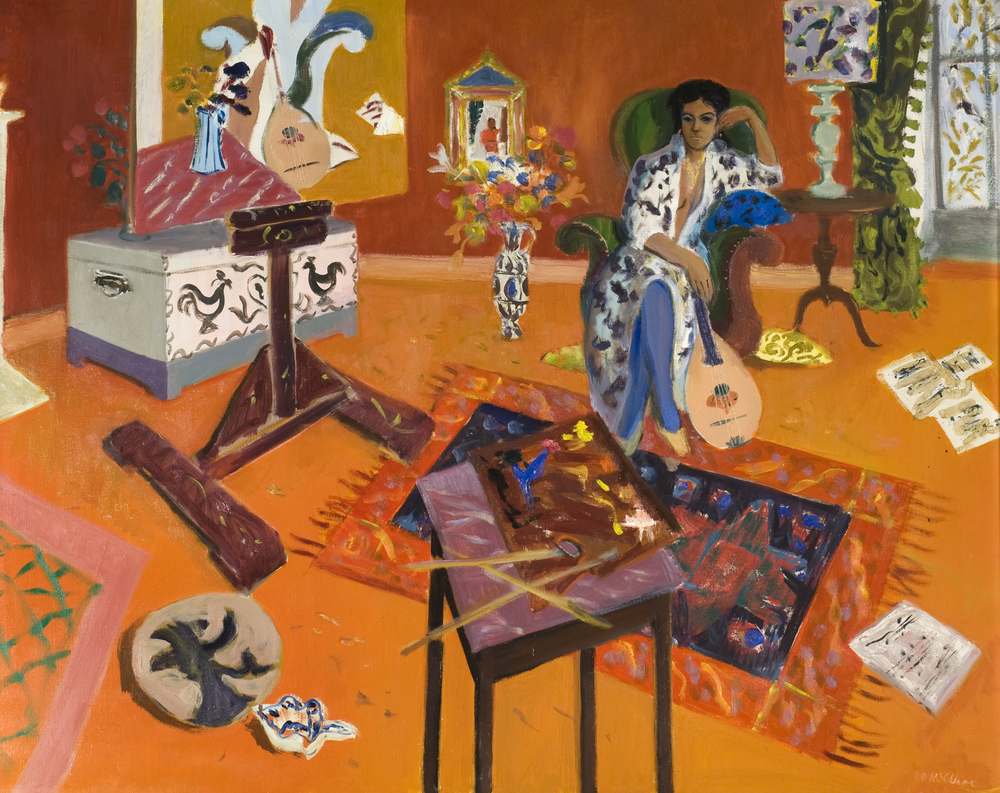
David McClure (1926-98), Girl in Orange Studio, 1969/1977 © The David McClure Estate
More people than ever have been working from home during lockdown, something with which artists with studio space in their houses are familiar. Girl in Orange Studio by David McClure (1926-98) is believed to be a combined view of his studio and sitting-room in Dundee. McClure was born in Lochwinnoch, Renfrewshire. He was educated at the universities of Glasgow and Edinburgh and at Edinburgh College of Art. In 1950 he married Joyce Flanigan and seven years of travelling, part-time teaching and painting concluded with his appointment as Lecturer in Drawing and Painting at Duncan of Jordanstone. On Morrocco’s retirement in 1982, McClure succeeded him as Head of Painting at the college.
Girl in Orange Studio comes from a celebrated series of interiors upon which McClure embarked in the late 1960s. With openly acknowledged references to the work of Henri Matisse (1869-1954), the painting is a bravura portrayal of a creative space. Various passages jostle for attention, from the model seated and holding a mandolin at the upper right, to the well-worked canvas on the easel, to the messy table covered in brushes and palette in the central foreground. Multiple viewpoints are employed at the same time, allowing us to view rugs and other items strewn over the floor from above, as well as the side planes of blanket box (painted by the artist), vase and table lamp. Bright colour and detailed patterned are barely contained in an image which pulsates with energy and optimism. Originally painted in 1969 and called ‘The Yellow Studio’, McClure returned to work on it further in 1977, when he renamed it ‘Girl in Orange Studio’. It was bought from the artist with the assistance of the National Fund for Acquisitions in 1982.
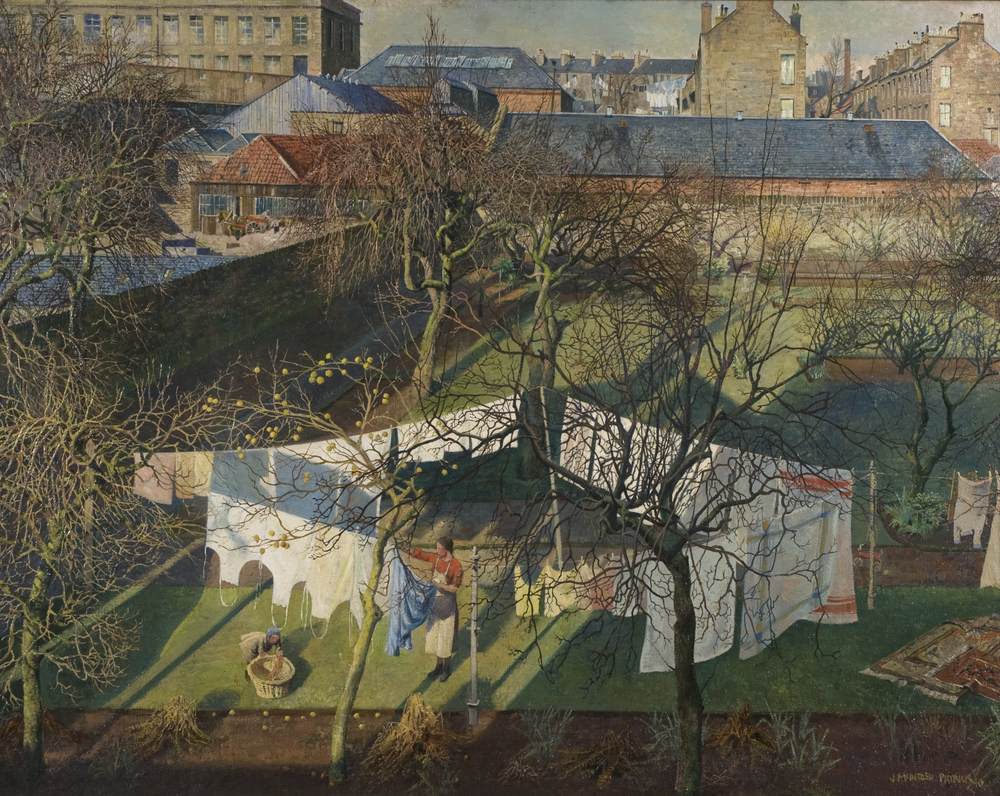
James McIntosh Patrick (1907-98), A City Garden, 1940 © The Artist's Estate
During lockdown, access to the outdoors has been severely restricted, making those lucky enough to have a garden appreciate it more than ever. A City Garden of 1940 by James McIntosh Patrick (1907-98) depicts the artist’s back garden in Dundee. McIntosh Patrick was born in the city and studied at Glasgow School of Art. He made his name as an etcher, but changed to painting after the collapse of the market for etchings during the Great Depression. After World War Two he became renowned for his highly-detailed, realistic landscapes and achieved great professional success.
McIntosh Patrick painted A City Garden whilst waiting to be called up to the army. His wife, Janet, is seen hanging out the washing, with their daughter, Ann, rummaging in a wicker basket to the lower left. Carpets waiting to be beaten are visible at the lower right. Meticulous attention is paid to the depiction of the bare branches of the trees and the plants in the flower beds. The long-flung shadows suggest a low, winter sun. Further washing can be glimpsed hung between the tenements in the background, suggesting that the work was made on a Monday, the traditional day on which to do the laundry. The garden is neat and well-tended, signs that it was used and enjoyed by the artist and his family. City Garden was purchased with the assistance of the Ower Bequest in 1940, shortly after it was completed.
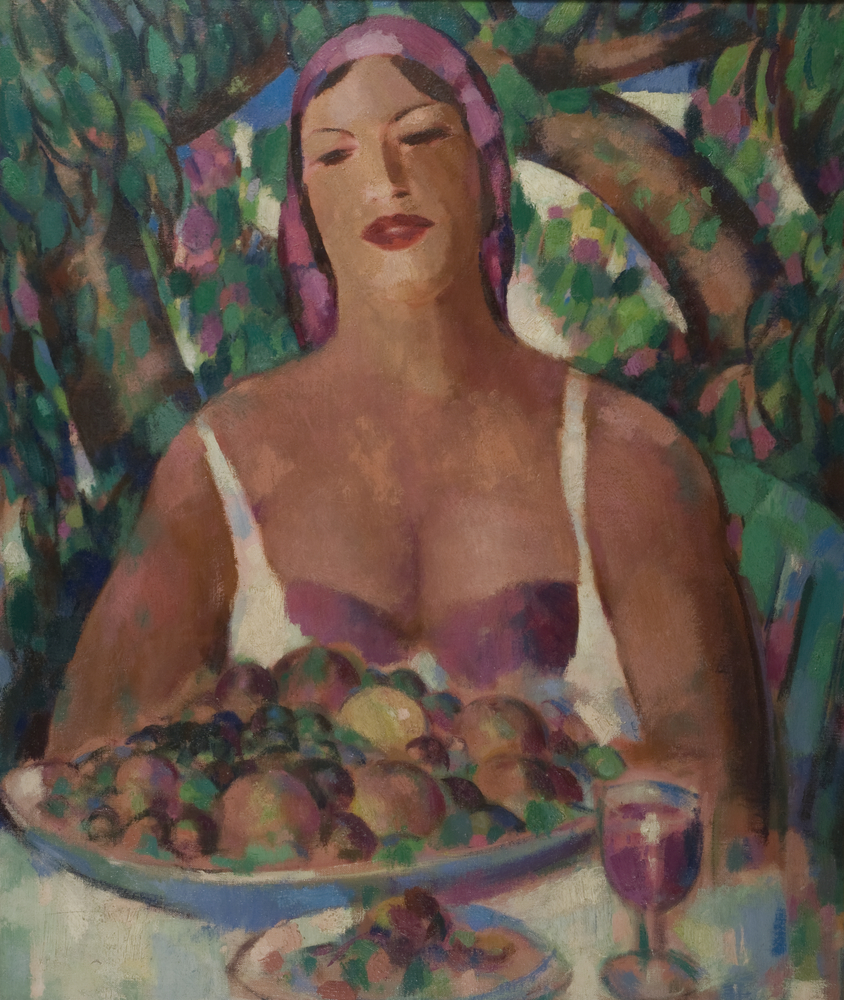
John Duncan Fergusson (1874-1961), Full of the Warm South, 1953 © The Fergusson Gallery, Perth & Kinross Council
As the summer season approaches and foreign holidays may not be possible, John Duncan Fergusson take us to France in Full of the Warm South of 1953. Fergusson was born in Leith, the port for Edinburgh. He was self-taught apart from sporadic attendance at the Académies Colarossi and Julian in Paris. He moved to the French capital in 1912 and was living in the Cap d’Antibes when World War One broke out. Although thereafter based in London and Glasgow, he returned to the area regularly with his partner, the dance pioneer Margaret Morris, until shortly before his death.
Many of the couple’s trips were based around Morris’s Summer Schools, at which Fergusson taught painting. Their students danced outdoors, in short, loose tunics and bare feet, revelling in freedom of movement and the Mediterranean climate. Full of the Warm South epitomises the joyful lifestyle Fergusson and Morris enjoyed in France. A tanned woman, dressed informally and seated at an outdoor table, smiles at the viewer from a luscious arbour. Dappled sunshine reaches her bare shoulders through leafy branches above. The fecundity of her surroundings is reflected in the dish overflowing with fruit on the table, accompanied by a glass of wine. The palette is as warm as the climate, with pink highlights used throughout to hold the composition together. The atmosphere is one of relaxation and contentment on holiday, which we hope to experience for ourselves once lockdown is a thing of the past. Full of the Warm South was purchased from the J. D. Fergusson Foundation with the assistance of the National Fund for Acquisitions in 1968.


